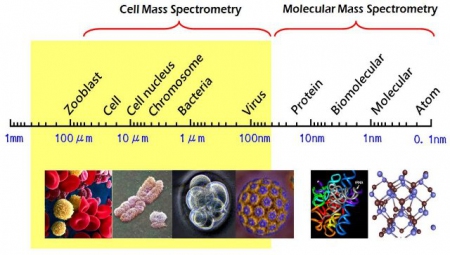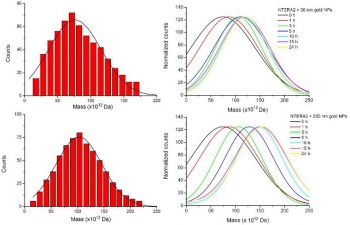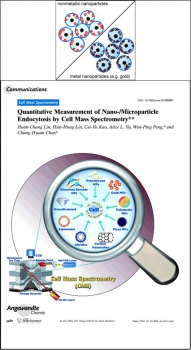In the pursuit of Bio-Marker and cancer treatment, there seems to be a “Gold Rush”, thanks to the Nanotechnology! While scientists have been using nanogold as a carrier to send therapeutic compounds into living cells, conventional Mass Spectrometry devices lack a way to measure the effectiveness of such researches.
 |
| diagram 1 |
Mass Spectrometry Technology has been a focal research topic of the Physical & Computational Genomics Division in Genomics Research Center. Dr. Chung-Hsuan Chen, head of the division, aims to develop a full-scale all-particle mass spectrometry device. Their progress has been steady and surely. In 2007, an innovative MS device (named as Charge-Monitoring Mass Spectrometer, aka, CMS) was developed to weigh a single cancer cell with a high speed by his team, in collaboration with Dr. Huan-Cheng Chang’s group at Institute of Atomic and Molecular Science and Dr. Ming-Lee Chu at Institute of Physics and Dr. Alice Yu’s group at the Genomics Researach Center in Academia Sinica.
Since it can be used for rapid cell measurement, it is also called as Cell Mass Spectrometer. Conventional MS devices can only weigh particles whose diameters are below 10 nanometers(diagram 1), thus, none of the viruses, bacteria, or cells can be analyzed easily. Therefore, CMS is a one of a kind MS device so far.
In the May issue (volume 49, issue 20) of the elite Journal “Angewandte Chemie”, highlighted in the Communication section, a recent study of the group by using the CMS to investigate the quantitative method of examining living cells before and after the uptake of nano-particles, including the hot pursued nanogold was reported.

Next, the group wanted to find out the difference for the target cells treated with and without nano-particles, like nanogold, by the CMS.
Currently, it is already a known fact that nano-particles in ball like shapes tend to be absorbed by living cells. There are also custom made nanogold particles by various diameters. Therefore, the team did in-vitro tests, let the living cells sit with nanogold for different durations.
Test results shows, after 15 hours, all the living cells were “full”. This proved the same for nanogold particles in sizes ranged from 30 nm to 250 nm. By the unique feature of CMS, the researchers could also determine how many nanogold particles were swallowed by each of the living cells.
The same experiments were carried out then using a nonmetal Polystyrene particle, it showed that the cells would also swallow these particles, each one of them, to a certain limit, then stopped and remained alive.
The finding is encouraging because even though by the Induction Coupled Plasma Mass Spectrometer (ICP-MS) conventionally available, the same result of examining the amount of nanogold swallowed by the cells could be achieved, it proved that it would take 5 steps by the ICP-MS method compared to 2 steps using CMS. Moreover, the total time spent by the ICP-MS way was 5 times longer than the CMS way. Even better is, CMS could detect the exact amount of particles absorbed by each cells, not just a statistical average.
CMS is the only device in the world to be able to measure the uptake of nonmetal nanoparticles by cells. Therefore it can be used for the measurement of drug uptake when drugs are carried by nanoparticles such as liposome. ICP-MS can not be used for measurements of the uptake of nonmetal nanoparticles.Due to the non-discriminative nature of CMS, it can be sure that as long as the nano-particles are in ball-like shapes, the CMS can detect if such particles are absorbed by cells. This can range from viruses, nanodaimonds, nanogold, liposomes, carbon nanotubes, and micelles (diagram 3).
This unique feature proves handy for biological researches. For example, while new drug discovery may find certain lead objects that have a sharp edge or must be in liquid form to exist, to effectively send the drug candidate to living cells, the currently best solution is to wrap them up in a ball-like nano-particle.
Chemicals that contain Photocatalyst (TiO2)proved to be effective in treating odors, bacteria, however, it may cause diseases if the amount is not well managed. By using CMS, the amount of TiO2 absorbed by cells could be measured with no problems! ”It is exciting that we have shown CMS can quickly detect the change in weight while nanoparticles were taken by cells. We expected that cell mass spectrometry is of importance in medical applications.”, claimed Huan-Chang Lin, the first author of this article who is currently a Ph.D student.
The CMS for nanoparticle uptake measurements is a collaborative effort by Dr. Chung-Hsuan Chen and Dr. Alice Yu of Genomics Research Center, and Dr. Wen-Ping Peng of Department of Physics of National Dong Hwa University. Drs. Chen and Peng are corresponding authors of this article and long term partners in the MS technology study. Peng is also a key member in developing the first CMS. Dr. Chen has devoted a significant part of his career life in developing the MS technology and aims to deliver a universal MS device for biomedical, environmental and energy applications. This research pushes their work one step closer to complete the story!
